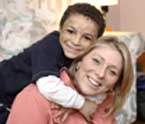
Tiffani Stroh and her son Colby today.
In the New Pediatric Burn Center
Tiffani Stroh was at work when she took the call. “Colby’s been burned!” cried his frantic father, telling her to meet them at the nearby hospital. En route, Tiffani did not anticipate the devastating toll on their 3-year-old son. A flash fire had burned the skin off his face and the back of his hands. His back, legs and feet were a mass of second and third degree burns. In an effort to clean his diaper in the basement of his father’s home, Colby had splashed on gasoline instead of detergent. A spark from the nearby furnace likely ignited the ensuing tragedy.
“In an instance, our whole life changed,” says Ms. Stroh, who traveled in the ambulance with Colby en route from the Dundalk, Md., hospital to Johns Hopkins Children’s Center, newly designated site of the Pediatric Burn Center for the State of Maryland. “It was your worst nightmare.”
Eighteen months later, Colby is running again and playing peewee soccer. When other children ask him about some skin discoloration on his smooth face, the 5-year-old has an easy answer. “Oh, I just got burned.”
He has little memory of his multiple surgeries and rigorous physical therapy at the Children’s Center, where he was hospitalized for two months, or the subsequent weeks at the Mt. Washington Pediatric Hospital, where he continued his rehabilitation. But when he finally returned home, says Stroh, “He was so well healed, he didn’t need dressing changes, and he was already in compression garments for his scarring.”
She credits Colby’s recovery to his care within the Children’s Center’s pediatric unit of the Johns Hopkins Burn Program, and on through rehab. The Johns Hopkins Burn Program, centered on the Bayview Campus, and headed by surgeon Stephen Milner, provides comprehensive research, education and care to adult and pediatric burn victims for the State of Maryland. The Johns Hopkins Children’s Center treats the most critically ill burned children - -those with substantial pulmonary issues. An estimated 100 burned children are expected to need the Children’s Center’s multidisciplinary approach in the coming year, and 300 patients will receive the services of its pediatric burn outpatient clinic. Children’s Center nurses, social workers, Child Life specialists and occupational therapists trained with Bayview colleagues and at pediatric burn centers across the county in preparation for the influx, which began last fall.
Director of the Pediatric Burn Center at the Children’s Center, pediatric plastic surgeon Rick Redett led the initial surgeries on Colby, those to clean his wounds and harvest skin for temporary grafting to prevent infection. New biological dressings on his second degree burns would eliminate frequent dressing changes. His third-degree burns required “aggressive support” from services like nutrition to keep his metabolic rates high and fuel healing, says Redett.
While his sedation was supervised by the Children’s Center’s pain management team, Colby’s burned legs were stretched the day after his first surgery, and every day thereafter, to keep the skin and tendons limber and prevent tightening into the taut contractions common in burn patients as their skin heals. Pediatric nutrition kept the toddler’s calories up over 4,000 daily. Kids require the additional nutrition to heal and grow more skin.
Once healing began, nurses and therapists massaged his limbs to keep the skin smooth and prevent scarring. A silicon-lined mask applied gentle pressure to the skin, to help keep it smooth. He underwent repeat surgeries to remove scar tissue from his face and ears, inner thighs and bottom legs, and skin transplants, including skin from his stomach to his face.
“The slight differences in skin pigments – are really the only indications on his little face that he was ever burned,” says Stroh. “His eyelashes, brows and eyes – they were able to save them all.”
Colby was fortunate. For many burn patients, disfigurement is a devastating aftermath. At the Mt. Washington Pediatric Hospital, rehabilitation includes outings into the community to learn how to manage the stares, questions and concerns of strangers and friends.
Colby faces a few more surgeries to remove scar tissues from his body, legs and arms, and is followed in the pediatric burn outpatient clinic at the Children’s Center. But his attitude and prognosis are excellent, his mother says. He figured early out how to use his burns to his advantage, in fact. “When he’d get into trouble back at home he’d say ‘I can’t sit in the corner, my fanny itches,’” she recalls. “I was so happy to have him back, so he could get in trouble. Hopkins saved my baby.”
